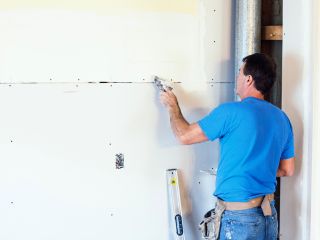
Drywall mud, also known as joint compound, is a versatile material used in drywall installation and repair. This white-colored substance is similar to plaster and is essential for sealing joints between drywall sheets. Whether applied by professionals or DIY enthusiasts, drywall mud ensures smooth finishes and secure applications. Below, we explore the most common types of drywall mud and their specific uses.
1. Taping Compound
Taping compound is specially formulated for the initial two layers of joint compound application during drywall installation. It’s used to fill gaps between drywall sheets before joint tape is applied over it. Once dried, a second layer of taping compound strengthens the bond and prevents cracking or shrinking. This material is ideal for ensuring a solid foundation for your drywall seams.
2. All-Purpose Compound
All-purpose compound is a versatile option that can be used for taping, topping, and texturing. It’s popular among homeowners because it works effectively across all three layers of joint compound application. While convenient, it’s less crack-resistant compared to other types, making it better suited for smaller projects or areas with minimal stress on the walls.
3. Topping Compound
The topping compound is applied as the final layer in drywall installations. It’s designed to cover previous coats and create a smooth surface ready for sanding and primer application. While it’s excellent for finishing touches, it cannot be used for adhering tape or filling gaps between drywall sheets.
4. Setting Compound
Setting compound is perfect for patching blemishes, repairing small holes, or addressing water damage in drywall. Its hard-drying formula offers superior bonding strength while resisting cracks and shrinkage. Unlike other compounds, setting mud allows additional layers to be applied without waiting for the first layer to dry. However, it requires careful handling due to its quick drying time (typically 20 minutes) and manual mixing requirements.
5. Lightweight Compound
Lightweight compounds are ideal for finishing coats due to their easy sanding properties and lighter shade that remains invisible under texturing layers. They contain fewer adhesive components, making them unsuitable for taping seams but perfect for corner bead layers or seam coats. Their ease of application makes them a favorite choice for achieving smooth finishes in residential projects.
Compatibility Between Compounds
All types of drywall mud are compatible with one another when applied in sequence rather than mixed together. Manufacturers recommend following specific guidelines to ensure optimal results during repairs or installations.
How Woodland Hills Drywall Experts Can Help
At Woodland Hills Drywall Company, we specialize in using the right combination of joint compounds tailored to your project’s needs:
- Precision Application: Our professionals ensure seamless finishes by selecting the best materials for each layer.
- Expert Repairs: From patching holes to addressing water damage, we use crack-resistant compounds for durable results.
- Custom Textures: Whether you prefer smooth finishes or intricate texturing designs, we deliver flawless craftsmanship.
- Local Expertise: Serving Woodland Hills with reliable drywall services backed by years of experience.
Let us handle your drywall needs with expertise and care—call us today to schedule your project!

